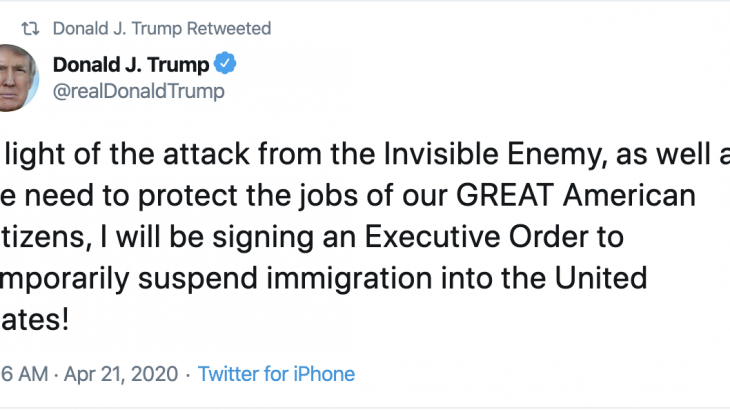President Trump has signed the Executive Order temporarily suspending some visa categories for an initial 60 days. This mostly applies to people outside the United States seeking permanent residency / Green Cards, excluding the EB-5 program.
The State Department has just issued a clarification stating that the Order is not retroactive and that “no valid visas will be revoked under this proclamation.”
There are a number of exclusions and exemptions. We recommend you contact us to discuss your specific circumstances.
What is NOT included in the ban:
- EB-5 Immigrant Investor Visa Program
- Those already in the United States on a valid immigrant visa*
- Those inside the US eligible for Adjustment of Status*
- Click here for the full list of exemptions
What is also NOT included in the ban, but subject to a 30-day review:
- All non-immigrant visas, including:
E-3 Australian Professional Specialty Visa
EB-5 Visas Exemption
The EB-5 Immigrant Investor Visa has been given a special exemption from the ban. EB-5 is a job-creating program. Each EB-5 investment is required to create ten American jobs. The EB-5 Immigrant Investor Program is a fast route to a Green Card for families or individuals able to invest $900,000.
Review of Non-Immigrant Visas
The Executive Order only covers immigrants outside the United States seeking permanent residency (Green Cards). Non-immigrant categories, such as the E-2 Visa, the L-1 Visa, and the H-1B Visa are not currently included in the ban.
However, the Executive Order does call for a review of non-immigrant programs within 30 days with a view to “other measures” affecting these categories. The Order instructs the Secretary of Labor, the Secretary of Homeland Security, and the Secretary of State to report recommendations to the President within 30 days regarding restrictions (if any) on non-immigrant visas.
Adjustment of Status
The order only applies to those seeking immigrant visas (i.e. those outside the US seeking to go through consular processing). It does not impact those inside the US already on a valid visa that are eligible to do Adjustment of Status (AOS). Clients should consult us before traveling outside of the United States if they have a pending AOS application or may be eligible to file one in the near future.
Our Advice
We recommend that anyone seeking a US visa proceed with their application. Much can change in the time it takes to prepare one.
With flights grounded and American embassies closed to consular appointments, the Executive Order makes limited material difference in the short term. There are likely to be a number of lawsuits challenging the ban. This is also an election year. A new administration could be expected to reverse this Order.
We will provide updates on the 30-day review of non-immigrant visas. Some non-immigrant categories, such as the E-2 Treaty Investor Visa, bring investment to the United States and create jobs.
Each client’s circumstances are different. Please contact us to discuss how this may affect you.



























